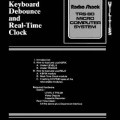Version Numbers
Computer software has always used version numbers, but there have been many different ways of managing them. (For an interesting history of version numbers, see the article The Amazing World of Version Numbers by Harry McCracken.)
Most personal computer software followed a consistent pattern of major and minor version numbers. I found this description of the Radio Shack approach to version numbering from the TRSDOS and DISK BASIC Reference Manual to be interesting:
Some of you may be a little confused about the terminology, “Version X.Y.” The “X” and “Y” will change as TRSDOS is updated, so here’s an explanation.
A new version represents a substantial expansion of the previous version. For example, new utilities, high-level languages, etc., might be included in a new version. Such versions are numbered by the integers 1, 2, 3, ….
A new release, on the other hand, is simply an update of the previous release of a given version. This later release generally included wider implementations and enhancements of commands and fixes for any problems in the earlier release. The releases are numbered by decimal fractions .1, .2, .3, ….
Therefore, when we refer to Version 2.3, that’s short for the third Release of Version 2.













